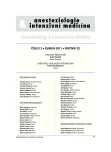Comparison of the cost of balanced anaesthesia maintained with or without nitrous oxide at a university hospital
Authors:
Adamus Milan 1; Koutná Jiřina 1; Hrabálek Lumír 2; Konupčíková Kateřina 1; Fischerová Lucie 1; Frančáková Jana 1
Authors‘ workplace:
Klinika anesteziologie a resuscitace, Lékařská fakulta Univerzity Palackého v Olomouci, Fakultní nemocnice Olomouc
1; Neurochirurgická klinika, Lékařská fakulta Univerzity Palackého v Olomouci, Fakultní nemocnice Olomouc
2
Published in:
Anest. intenziv. Med., 22, 2011, č. 2, s. 90-94
Category:
Anaesthesiology - Original Paper
Overview
Objective:
To compare the cost of balanced anaesthesia with or without nitrous oxide.
Design:
A prospective, clinical, randomized, non-blinded study.
Setting:
Department of anaesthesiology, university hospital.
Materials and methods:
Following local ethics committee approval and after obtaining informed consent, patients scheduled for elective surgery under balanced anaesthesia with tracheal intubation were studied. The patients were randomized into two groups with different anaesthetic gases used. In Group AIR, air/oxygen/sevoflurane was administered; in Group N2O, nitrous oxide/oxygen/sevoflurane was used. The cost of the anaesthetic gases and sevoflurane was determined and the Mann-Whitney test was used to compare the expenses in the two groups. The results were expressed as median and quartiles; P value less than 0.05 was considered statistically significant.
Results:
In Group AIR (10 males, 28 females) and Group N2O (7 males, 35 females), the demographics and duration of surgery were similar. The inhalational component of anaesthesia was more expensive in Group AIR (p = 0.005), due to higher consumption of sevoflurane (p = 0.001). There was no difference in the cost of oxygen between the groups (p = 0.138). Less sufentanil was used in Group N2O (p = 0.047). The consumption of the remaining anaesthetic agents (midazolam, propofol) and neuromuscular blocking agents (cisatracurium, rocuronium) was equal in Group AIR and Group N2O.
Conclusion:
Using nitrous oxide as part of balanced inhalational anaesthesia reduced the cost of anaesthesia.
Keywords:
pharmaco-economics – balanced anaesthesia – nitrous oxide – sevoflurane
Sources
1. Doležal, T., Prokeš, M., Sechser, T., Skoupá, J., Švihovec, J., Tichopád, A. Základy farmakoekonomiky pro lékaře, lékárníky a další pracovníky ve zdravotnictví. 1. vydání. Praha: ČFES, 2007, 99 s. ISBN 978-80-254-0837-7.
2. Nitrous oxide. From Wikipedia, the free encyclopedia [online]. Cit. 20. 12. 2010. Dostupný na www: http://en.wikipedia. org/wiki/Nitrous_oxide
3. Pasternak, J. J., Lanier, W. L. Is nitrous oxide use appropriate in neurosurgical and neurologically at-risk patients? Curr. Opin. Anaesthesiol., 2010, 23, p. 544–550.
4. Lassen, H. C., Henriiksen, E., Neukirch, F., Kristensen, H. S. Treatment of tetanus; severe bone-marrow depression after prolonged nitrous-oxide anaesthesia. Lancet, 1956, 270, p. 527–530.
5. Sanders, R. D., Weimann, J., Maze, M. Biologic effects of nitrous oxide: a mechanistic and toxicologic review. Anesthesiology, 2008, 109, p. 707–722.
6. Leslie, K., Myles, P. S., Chan, M. T., Forbes, A., Paech, M. J., Peyton, P., Silbert, B. S., Williamson, E. Nitrous Oxide and Long-Term Morbidity and Mortality in the ENIGMA Trial. Anesth. Analg., 2010, [Epub ahead of print]. doi:10.1213/ANE.0b013e3181f7e2c4.
7. Myles, P. S., Leslie, K., Peyton, P., Paech, M., Forbes, A., Chan, M. T., Sessler, D., Devereaux, P. J., Silbert, B. S., Jamrozik, K., Beattie, S., Badner, N., Tomlinson, J., Wallace, S.; ANZCA Trials Group. Avoidance of nitrous oxide for patients undergoing major surgery: a randomized controlled trial. Anesthesiology, 2007, 107, p. 221–231.
8. Reynolds, E. Vitamin B12, folic acid, and the nervous system. Lancet Neurol., 2006, 5, p. 949–960.
9. McNeely, J. K., Buczulinski, B., Rosner, D. R. Severe neurological impairment in an infant after nitrous oxide anesthesia. Anesthesiology, 2000, 93, p. 1549–1550.
10. Schneemilch, C. E., Hachenberg, T., Ansorge, S., Ittenson, A., Bank, U. Effects of different anaesthetic agents on immune cell function in vitro. Eur. J. Anaesthesiol., 2005, 22, p. 616–623.
11. Badner, N. H., Beattie, W. S., Freeman, D., Spence, J. D. Nitrous oxide-induced increased homocysteine concentrations are associated with increased postoperative myocardial ischemia in patients undergoing carotid endarterectomy. Anesth. Analg., 2000, 91, p. 1073–1079.
12. Nygard, O., Nordrehaug, J. E., Refsum, H., Ueland, P. M., Farstad, M., Vollset, S. E. Plasma homocysteine levels and mortality in patients with coronary artery disease. N. Engl. J. Med., 1997, 337, p. 230–236.
13. Mazze, R. I., Kallen, B. Reproductive outcome after anesthesia and operation during pregnancy: A registry study of 5405 cases. Am. J. Obstet. Gynecol., 1989, 161, p. 1178–1185.
14. Dostálová, K., Doubravská, L., Fritscherová, Š., Pospíšilová, D., Zapletalová, J., Adamus, M. Pooperační bolesti v krku. Anest. intenziv. med., 2010, 21, p. 172–178.
15. Doubravska, L., Dostalova, K., Fritscherova, S., Zapletalova, J., Adamus, M. Incidence of postoperative nausea and vomitong in patients at a university hospital. Where are we today? Biomed. Pap. Med. Fac. Univ. Palacky Olomouc Czech Repub., 2010, 154, 1, p. 69–76.
16. Černý, V., Cvachovec, K., Ševčík, P., Vítková, K., Minarčíková, P. Gavulová, E., Dostálová, V., Schreiberová, J., Novotný, T., Machalová, G., Brujevič, J., Silová, X., Stozsková, A., Parnicová, E. Doba úvodu a zotavení z celkové anestezie – prospektivní studie. Anest. intenziv. Med., 2007, 20, p. 236–240.
17. Černý, V., Adamus, M., Cvachovec, K., Ševčík, P., Herold, I. Anestezie v České republice 2010 – jednodenní prospektivní observační dotazníková studie. Anest. intenziv. Med., 2011, 22, 1, s. 5–12.
18. Shine, K. P. The global warming potential – the need for an interdisciplinary retrial: an editorial comment. Climatic Change, 2009, 96, p. 467–472.
19. Shine, K. P. Climate effect of inhaled anaesthetics. Br. J. Anaesth., 2010, 105, p. 731–733.
20. Sulbaek Andersen, M. P., Sander, S. P., Nielsen, O. J., Wagner, D. S., Sanford, T. J., Wallington, T. J. Inhalation anaesthetics and climate change. Br. J. Anaesth., 2010, 105, p. 760–766.
Labels
Anaesthesiology, Resuscitation and Inten Intensive Care MedicineArticle was published in
Anaesthesiology and Intensive Care Medicine

2011 Issue 2
Most read in this issue
- Summary of the most important changes in the Guidelines for cardiopulmonary resuscitation
- Perioperative haemodynamic optimization
- Neuromuscular blockade during general anaesthesia in the Czech Republic 2010 – a one-day, prospective, observational survey
- Potential impact of criminal charges and claims of inadequate health care on the physicians‘ performance
